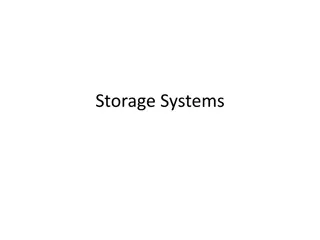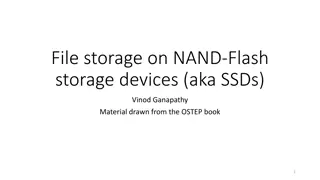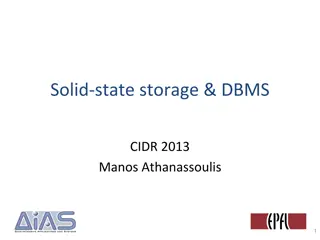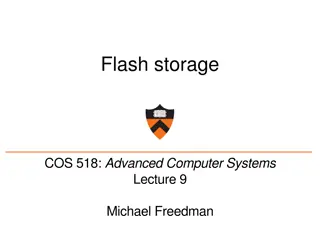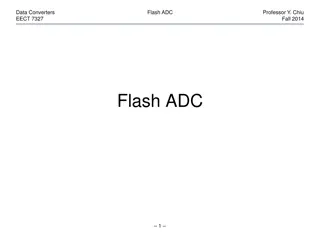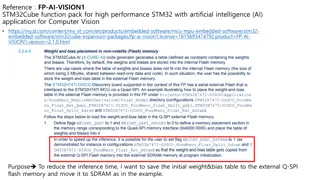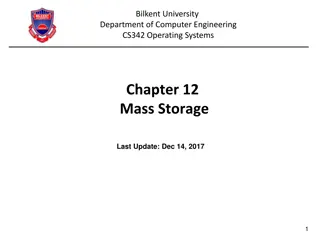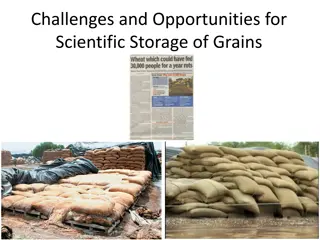Understanding F2FS: A File System for Flash Storage
F2FS, a file system designed for flash storage, addresses the limitations of NAND flash memory including erase-before-write, limited write cycles, and efficiency with random writes. Its main design points focus on using zone, section, and segment units for storage allocation and cleaning, as well as implementing multi-headed logging and adaptive logging strategies for improved performance. The on-disk layout of F2FS divides a volume into six key areas for storage management.
Download Presentation

Please find below an Image/Link to download the presentation.
The content on the website is provided AS IS for your information and personal use only. It may not be sold, licensed, or shared on other websites without obtaining consent from the author. Download presentation by click this link. If you encounter any issues during the download, it is possible that the publisher has removed the file from their server.
E N D
Presentation Transcript
F2FS: A File System for Flash Storage
Introduction NAND flash memory is broadly used However, NAND flash has the following limitations Erase before write Limited write cycles per erase block NAND flash does not work well with random writes Can cause internal fragmentations and degrade sustained SSD performance Random write patterns are common Facebook mobile app (150% more random than sequential writes) WebBench (70% more random than sequential writes) Due to the use of SQLite
Main F2FS Design Points Based on LFS Use zone > section > segment units Allocate storage in segments Clean in sections Aligned with FTL operational units
Main F2FS Design Points Use node address table <node ID, address> to solve the wandering tree problem (see slides 8 & 9) LFS appends data <data> and index block <index block, data address> It s index map block <index map, index block address> also needs to be updated Instead, index block and index map store data node ID and index block node ID Only the node address table needs to be updated
Main F2FS Design Points Multi-headed logging Separate hot and cold data Runs multiple log segments concurrently Appends data and metadata to separate log segments Exploits parallelism Adaptive logging Use append to convert random writes into sequential ones When the storage is near full, use threaded logging Fsync acceleration and roll-forward recovery
On-Disk Layout F2FS splits a volume into six areas (see slide 7) Superblock Checkpoint Segment information table (SIT) contains validity bitmap Node address table (NAT) for nodes stored in the main area Segment summary area (SSA) stores parent inode number and its node/data offsets Main area stores 4KB blocks A node contains indices of data blocks Data block contains directory or file data
F2FS Update with Node Translation Table
Directory Structure 4KB directory entries Bitmap with <slot, name> pairs Slot contains hash value, inode number, file length, file type A directory file uses multi-level hash tables
Multi-head Logging Maintains six log areas Three levels of temperatures Hot, warm, and cold Type Node Temperature Hot Warm Cold Hot Warm Cold Objects Direct node blocks for directories Direct node blocks for files Indirect node blocks Directory entry blocks Data blocks Data blocks moved by cleaning Multimedia file data Data
Cleaning Foreground Background Triggered when not enough space Triggered periodically Uses cost-benefit policy Picks sections with the fewest valid segments Also considers the age of sections Migrate immediately Lazy migration Merges segments and leaves them in memory
Fsync optimization Write data blocks and their direct node blocks only Excluding other node or metadata blocks Leverage checkpoints to recover
Performance Compared to ext4 3x for iozone 2x for SQLite






